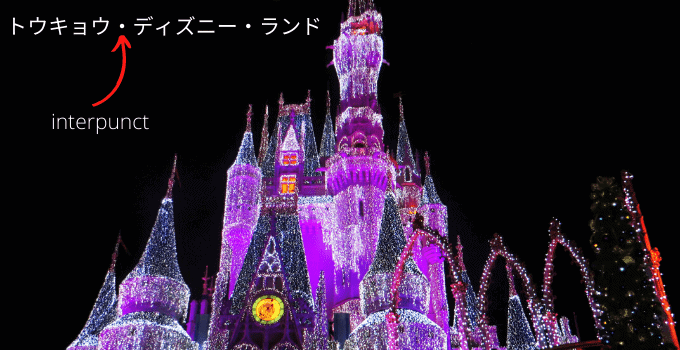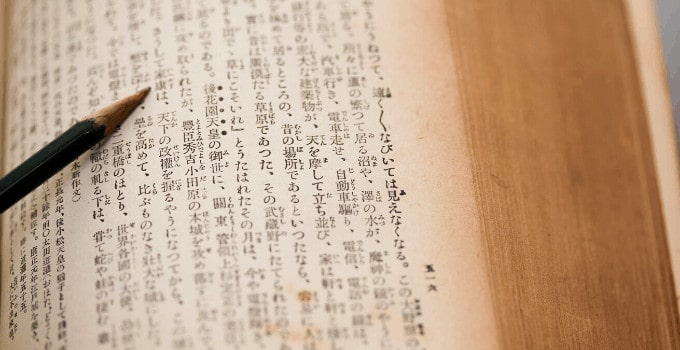Orthography is the study of a given language’s writing conventions.
In English, for example, orthography deals not just with spelling and grammar, but also with punctuation marks like the period or exclamation mark and the use of spaces.
Of course, every language has its own conventions.
Japanese orthography in particular has to contend with three different writing systems, but otherwise it’s fairly straightforward.
And if you’re one of those people who gets riled up about the age-old debate of “one space or two after a period,” you’ll be pleased to know that this is not something you will need to worry about in Japanese.
That’s because written Japanese does not use spaces in most cases. Although many sites will say you never use spaces in Japanese, this is not strictly true, as we will see.
So what’s the real deal with spaces in Japanese writing? Read on and find out.
A note on Japanese orthography
Before we get into the issue of spaces, let’s take a brief detour through the long and complicated history of Japanese writing.
Given that Japanese, unlike English, has four different writing systems, perhaps that isn’t a surprise.
All the same, new learners of Japanese might be interested to know that the hiragana and katakana syllabaries which are one of the first things you learn were actually themselves written in Chinese characters to begin with.
Additionally, even the most detailed kanji today pales in comparison to some of the more obscure characters used regularly hundreds of years ago.
In short, Japanese governments and education councils have made numerous changes to the orthography of Japanese since at least the late 1800s.
For the most part, these changes involved simplifications to kanji and the removal of particularly esoteric Chinese-derived characters or the designation of some hiragana as obsolete.
Today there are two main sets of kanji taught in schools, and you need to learn about 3,000 characters to be considered literate.
Although that seems high, the fact is that Japan’s orthographic changes have made becoming fully literate much easier than before.
One thing that hasn’t changed, to bring us back to our main topic, is the use of spaces.
Why you don’t need spaces between Japanese words
The main reason spaces are unnecessary in Japanese has to do with the mix of writing systems already mentioned.
Although this makes it more complicated to learn to read and write in Japanese, the mixture of hiragana, katakana and kanji in a single sentence means that parsing out different words is much more easy than if only a single form were used.
It’s unlikely, for instance, that anyone is going to think the で in です (is/are) should actually be part of 本当 (“really”) in the sentence 「それは本当ですか?」 or that the meaning of the full sentence has do to with a book (本).
The different types of Japanese writing mean spaces usually aren’t necessary.
Full-width and half-width characters

A more recent explanation for the no-space phenomenon has to do with computers.
The traditional Japanese syllabaries all use what are called “full-width” (全角 or zenkaku) characters. Basically, these characters are extra wide on a screen.
English characters, on the other hand, are half-width (半角 or hankaku).
If you look at Japanese characters above English ones, the difference is immediately apparent:
それ
that
Outside of a few specialist fonts, English characters take up significantly less horizontal space. The same is true, more or less, for written English and written Japanese as well.
Japanese characters are wider by nature, so they spread out more along the page.
This means you can fit more English words in a line of text than you can Japanese ones, but it also means Japanese writing is significantly easier to read without spaces.
Introducing the interpunct

In long strings of katakana being used to represent foreign names, the benefits of Japanese’s multiple writing systems can disappear.
For these cases, instead of a space Japanese has a special piece of punctuation called the “interpunct” (中点 or nakaten). This is a period-like dot that appears vertically centered in between two words to separate them.
Instead of トウキョウディズニーランド (Tokyo Disney Land), for instance, you could write トウキョウ・ディズニー・ランド to aid in clarity.
Sometimes, though, the interpunct isn’t enough.
Let’s look at the rare exceptions when you will see spaces in Japanese writing.
Japanese books and spaces

One exception is when reading prose published in book form.
Printed books use vertical text, rather than horizontal text, and you will sometimes see a space at the start (that is, at the top) of a line.
This space is similar to an indent at the beginning of a paragraph in English, and simply indicates that a new paragraph has started.
Spaces are also included if you are looking at traditional Japanese poetry like the haiku (俳句) or tanka (短歌), which are written in one or more vertical lines and may use spacing in non-standard ways.
Spaces and Japanese names

Another exception to the no-space rule is when it comes to people’s names.
Most words can be easily parsed without spaces due to the breaks in kanji and hiragana, and due to their commonly understood meanings.
The same is not true for many names.
Despite there being a set list of characters for use in names, there are so many possible combinations which could be read different ways that spaces are used between the family name and personal name.
For example, the name of famous haiku poet Masaoka Shiki is written in Japanese as 正岡 子規 and not 正岡子規.
The space here makes it clear what is a surname and what is a personal name.
Spaces in romaji and educational materials

The other few places you might see spaces in Japanese are also edge cases.
If something is written in romaji, spaces are used just like with English. As noted earlier, while hiragana, kanji and katakana are full-width fonts, romaji is half-width.
This means spaces are necessary between words to aid in clarity.
Another places where spaces might show up is in children’s books or in other materials written with education in mind.
Because Japanese children are not as familiar with reading, and certainly won’t know many kanji, children’s books are usually written entirely in hiragana and spaces are often added to help them figure out where words begin and end.
Some beginning educational materials aimed at adults learning Japanese will follow the same rules for the same reason, although it’s always beneficial to move away from these materials and onto ones which present Japanese as it would be written in normal society as soon as you can.
Regardless, these are a few of the very rare exceptions to the general lack of spaces in written Japanese.
Examples
“kore wa nani desu ka?”
Although we could eventually tease out the meaning of this romaji sentence if it were “korewananidesuka,” it’s a lot harder than with hiragana and kanji: 「これは何ですか。」
(Note also that romaji has its own rules, and は is transliterated as “wa” instead of “ha” in most cases.)
「いぬ は わん わん と いいます。」
“The puppy says woof, woof.”
You might find this example in a Japanese children’s book. Notice how each word is very clearly distinct from others.
「たなかさん は あおい が すき です。」
“Tanaka likes the color blue.”
This sentence would look at home in a beginner’s Japanese textbook.
Like our romaji-only example, hiragana-only sentences are a bit hard to parse without spaces: 「たなかさんはあおいがすきです。」and 「いぬはわんわんといいます。」 are difficult on the eyes.
The benefit of learning kanji and katakana at the same time as hiragana and basic grammar is really apparent when considered in this light.
Wrap-up: Are there spaces in Japanese?
The short answer to this question is that Japanese orthography does not typically involve spaces.
The basic purpose of a space is to aid with clarity, and the different Japanese writing systems already make it fairly easy to tell which characters belong to which words.
When it comes to typing, almost all Japanese fonts are what is known as “full width,” meaning they take up more space horizontally the English (“half width”) fonts.
This does mean that you will sometimes see what appears to be a space after a period, question mark, or other form of punctuation.
However, you should not add one in your own writing. In some cases, such as a foreign name written out in katakana, the “interpunct” is used to aid in clarity instead of a space.
Generally speaking, the only times you will see spaces in Japanese are if you’re reading a book, where one is used to indicate a new paragraph, when something is written in romaji, when writing a person’s surname and personal name or if you’re looking at Japanese educational materials, where spaces may be added in between hiragana words to aid the learner.

Hey fellow Linguaholics! It’s me, Marcel. I am the proud owner of linguaholic.com. Languages have always been my passion and I have studied Linguistics, Computational Linguistics and Sinology at the University of Zurich. It is my utmost pleasure to share with all of you guys what I know about languages and linguistics in general.

